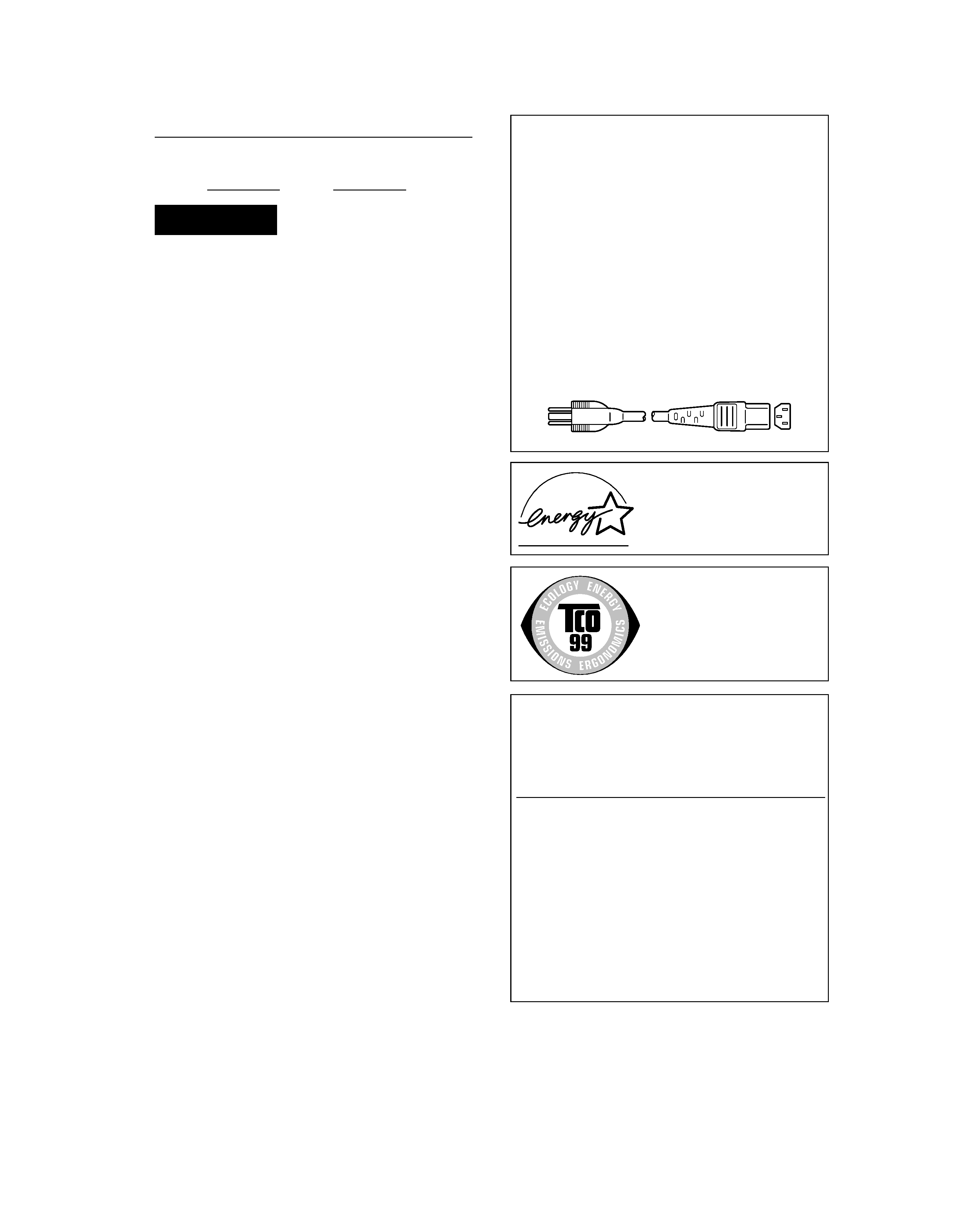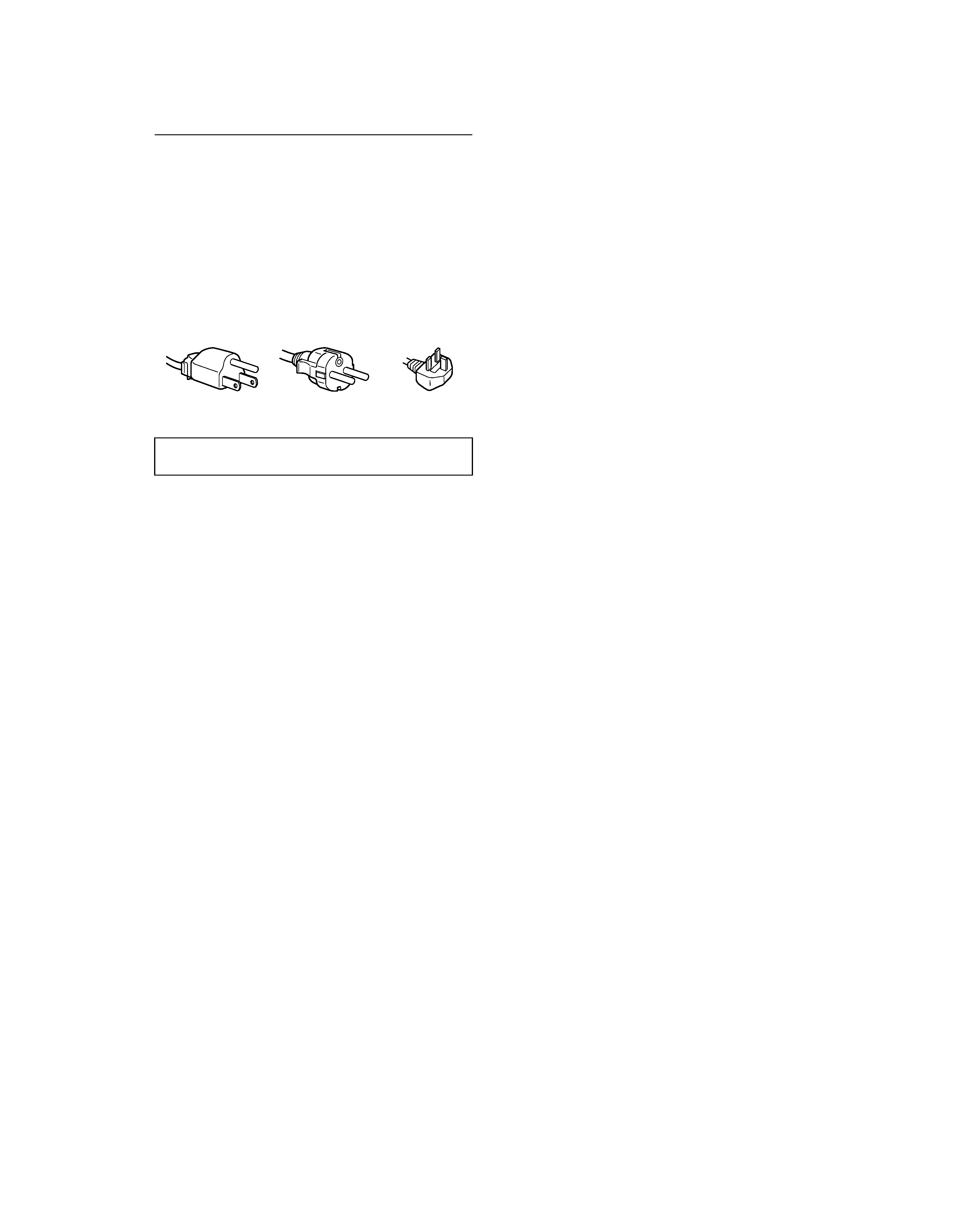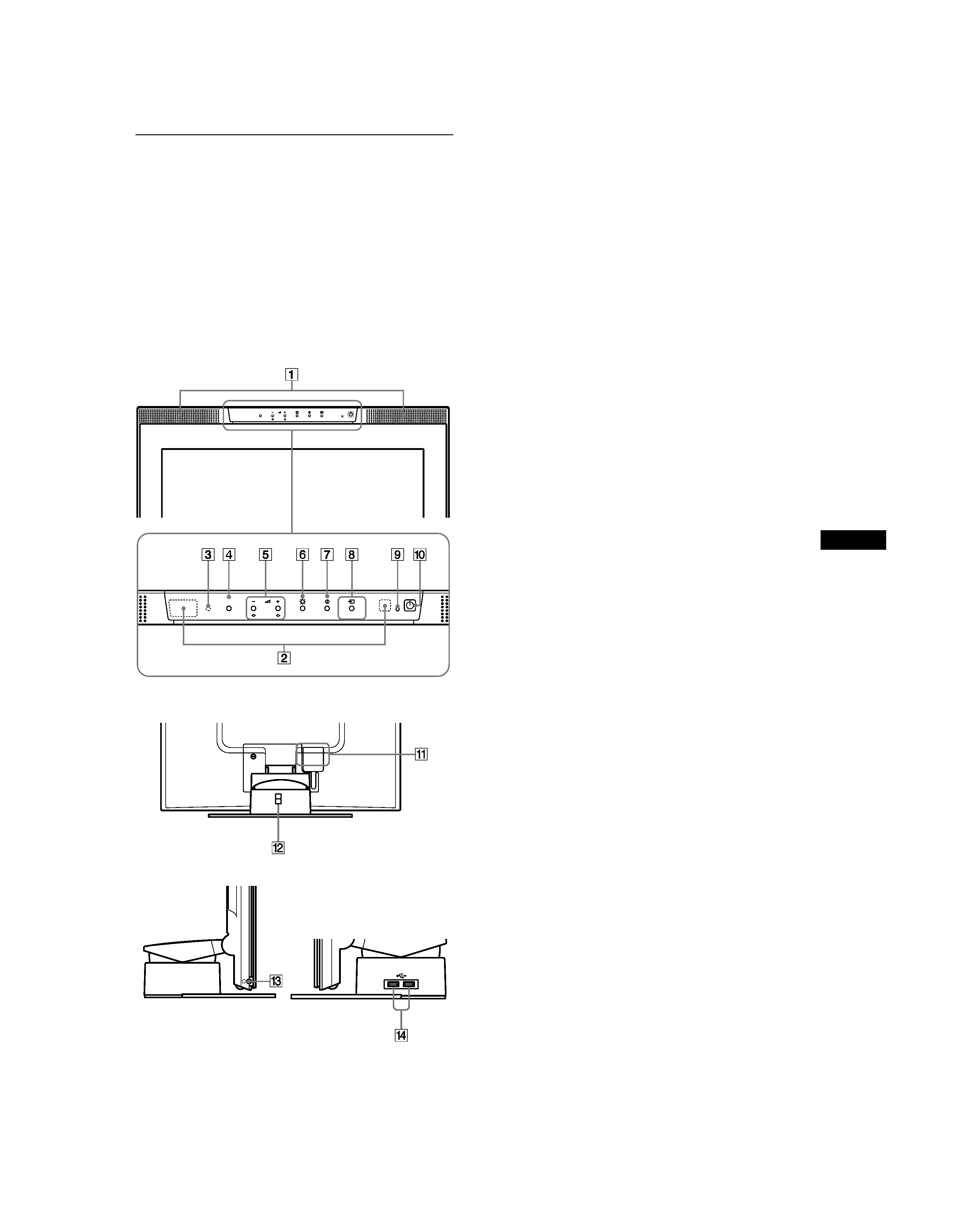
Operating Instructions
Mode d'emploi
Bedienungsanleitung
Manual de instrucciones
Istruzioni per l'uso
4-082-671-12(1)
© 2001 Sony Corporation
TFT LCD Color
Computer Display
GB
G:\_Upload\4082671121\4082671121SDMN80AEP\01COV-SDMN80AEP\01GB01COV-AEP.fm
masterpage:Right
SDM-N80
4-082-671-12 (1)
DE
FR
IT
ES
TF
T
L
C
D
Color
C
omp
u
te
r
D
is
p
la
y
SD
M
-N
8
0
SDM-N80
01GB01COV-AEP.book Page 1 Monday, July 16, 2001 2:21 PM

2
G:\_Upload\4082671121\4082671121SDMN80AEP\01COV-SDMN80AEP\01GB02GET-AEP.fm
masterpage:Left
SDM-N80
4-082-671-12 (1)
Owner's Record
The model and serial numbers are located at the rear of the unit.
Record these numbers in the spaces provided below. Refer to them
whenever you call upon your dealer regarding this product.
Model No.
Serial No.
To prevent fire or shock hazard, do not expose the
unit to rain or moisture.
Dangerously high voltages are present inside the
unit. Do not open the cabinet. Refer servicing to
qualified personnel only.
FCC Notice
This equipment has been tested and found to comply with the limits
for a Class B digital device, pursuant to Part 15 of the FCC Rules.
These limits are designed to provide reasonable protection against
harmful interference in a residential installation. This equipment
generates, uses, and can radiate radio frequency energy and, if not
installed and used in accordance with the instructions, may cause
harmful interference to radio communications. However, there is no
guarantee that interference will not occur in a particular installation.
If this equipment does cause harmful interference to radio or
television reception, which can be determined by turning the
equipment off and on, the user is encouraged to try to correct the
interference by one or more of the following measures:
Reorient or relocate the receiving antenna.
Increase the separation between the equipment and receiver.
Connect the equipment into an outlet on a circuit different from
that to which the receiver is connected.
Consult the dealer or an experienced radio/TV technician for help.
You are cautioned that any changes or modifications not expressly
approved in this manual could void your authority to operate this
equipment.
INFORMATION
This product complies with Swedish National Council for Metrology
(MPR) standards issued in December 1990 (MPR II) for very low
frequency (VLF) and extremely low frequency (ELF).
INFORMATION
Ce produit est conforme aux normes du Swedish National Council
for Metrology de décembre 1990 (MPR II) en ce qui concerne les
fréquences très basses (VLF) et extrêmement basses (ELF).
INFORMACIÓN
Este producto cumple las normas del Consejo Nacional Sueco para
Metrología (MPR) emitidas en diciembre de 1990 (MPR II) para
frecuencias muy bajas (VLF) y frecuencias extremadamente bajas (ELF).
WARNING
NOTICE
This notice is applicable for USA/Canada only.
If shipped to USA/Canada, install only a UL LISTED/CSA
LABELLED power supply cord meeting the following
specifications:
SPECIFICATIONS
Plug Type
Nema-Plug 5-15p
Cord
Type SVT or SJT, minimum 3
× 18 AWG
Length
Maximum 15 feet
Rating
Minimum 10 A, 125 V
NOTICE
Cette notice s'applique aux Etats-Unis et au Canada
uniquement.
Si cet appareil est exporté aux Etats-Unis ou au Canada, utiliser
le cordon d'alimentation portant la mention UL LISTED/CSA
LABELLED et remplissant les conditions suivantes:
SPECIFICATIONS
Type de fiche
Fiche Nema 5-15 broches
Cordon
Type SVT ou SJT, minimum 3
× 18 AWG
Longueur
Maximum 15 pieds
Tension
Minimum 10 A, 125 V
As an
ENERGY STAR Partner, Sony
Corporation has determined that this
product meets the
ENERGY STAR
guidelines for energy efficiency.
This monitor complies with the
TCO'99 guidelines.
If you have any questions about this product, you may call:
Sony Customer Information Center
1-800-222-SONY (7669)
or write to:
Sony Customer Information Center
1 Sony Drive, Mail Drop #T1-11, Park Ridge, NJ 07656
Declaration of Conformity
Trade Name:
SONY
Model No.:
SDM-N80
Responsible Party:
Sony Electronics Inc.
Address:
680 Kinderkamack Road, Oradell, NJ
07649 USA
Telephone No.:
201-930-6972
This device complies with Part 15 of the FCC Rules. Operation is
subject to the following two conditions: (1) This device may not
cause harmful interference, and (2) this device must accept any
interference received, including interference that may cause
undesired operation.
01GB01COV-AEP.book Page 2 Monday, July 16, 2001 2:21 PM

3
Table of Contents
· Macintosh is a trademark licensed to
Apple Computer, Inc., registered in the
U.S.A. and other countries.
· Windows is registered trademark of
Microsoft Corporation in the United
States and other countries.
· IBM PC/AT and VGA are registered
trademarks of IBM Corporation of the
U.S.A.
· VESA and DDC are trademarks of the
Video Electronics Standards
Association.
·
ENERGY STAR is a U.S. registered
mark.
· All other product names mentioned
herein may be the trademarks or
registered trademarks of their respective
companies.
·Furthermore, "
"and ""are not
mentionedineachcaseinthis manual.
GB
G:\_Upload\4082671121\4082671121SDMN80AEP\02GB-SDMN80AEP\01GB01COV-AEPTOC.fm
masterpage:Toc.master
SDM-N80
4-082-671-12(1)
Precautions... ... ... ... ... .... ... ... ... .... ... ... ... ... 4
Identifyingparts and controls . .... ... ... ... .... ... ... ... ... 5
Setup .......... ........... .......... ...........7
Step 1: Connect the media engine to your computer . . . . . . . . . . . . 7
Step 2: Check the digital/analog select switch . .... ... ... ... ... 7
Step 3: Connect the display andmedia engine .... ... ... ... ... 8
Step 4: Connect the audio cord . . . . . . . . . . . . .... ... ... ... ... 8
Step 5: Connect the power cord... ... ... ... .... ... ... ... ... 8
Step 6: Turn on themonitor and computer ... .... ... ... ... ... 8
Connecting Universal Serial Bus (USB) compliant peripherals . . . . 9
Using the stereo speakers ... .... ... ... ... .... ... ... ... .. 10
Selectingthe inputsignal . ... .... ... ... ... .... ... ... ... .. 10
Adjustingthe tilt and height... .... ... ... ... .... ... ... ... .. 11
CustomizingYour Monitor ... .......... ..........12
Navigating themenu . . ... ... .... ... ... ... .... ... ... ... .. 12
Adjustingthe contrast (CONTRAST) .. ... ... .... ... ... ... .. 13
Adjusting the black level of an image (BRIGHTNESS). . . . . . . . . . 14
Eliminating flicker or blurring (PHASE/PITCH)
(Analog RGB signals only). . . .... ... ... ... .... ... ... ... .. 14
Adjusting the picture position (H CENTER/V CENTER)
(Analog RGB signals only). . . .... ... ... ... .... ... ... ... .. 15
Adjustingthe color temperature (COLOR) . ... .... ... ... ... .. 15
Changing the picture size according to the signal (ZOOM) . . . . . . 16
Smoothing the picture (SMOOTHING) . ... ... .... ... ... ... .. 16
Changing the menu's position (MENU POSITION) . . . . . . . . . . . . 16
Resetting theadjustments (RESET) ... ... ... .... ... ... ... .. 17
Additionalsettings. ... ... ... .... ... ... ... .... ... ... ... .. 17
Technical Features ......... .......... ..........19
Power saving function (user sensor/power saving mode) . . . . . . . 19
If the user sensor does not seem to function properly . . . . . . . . . . 19
Automatic brightness adjustmentfunction (lightsensor) ... ... .. 21
Automatic picture quality adjustment function
(Analog RGB signals only). . . .... ... ... ... .... ... ... ... .. 21
Troubleshooting. ........... .......... ..........22
On-screenmessages . ... ... .... ... ... ... .... ... ... ... .. 22
Troublesymptoms and remedies .. ... ... ... .... ... ... ... .. 23
Self-diagnosis function . . . . . . .... ... ... ... .... ... ... ... .. 26
Specifications... ........... .......... ..........26
Appendix....... ........... .......... ...........i
Preset mode timing table . ... .... ... ... ... .... ... ... ... ....i
TCO'99 Eco-document ... ... .... ... ... ... .... ... ... ... ....i
01GB01COV-AEP.book Page 3 Monday, July 16, 2001 2:22 PM

4
D:\SDM\n80\N80GB\001009\3868361251\386836125SDMN50AEP\02GB-
SDMN50AEP\01GB02BAS-AEP.fm
masterpage:Left
SDM-N80
4-082-671-12(1)
Precautions
Warning on power connections
· Use the supplied power cord. If you use a different power cord,
be sure that it is compatible with your local power supply.
For the customers in the U.S.A.
If you do not use the appropriate cord, this monitor will not
conform to mandatory FCC standards.
For the customers in the UK
If you use the monitor in the UK, be sure to use the appropriate
UK power cord.
Installation
Do not install or leave the monitor:
· In places subject to extreme temperatures, for example near a
radiator, heating vent, or in direct sunlight. Subjecting the
monitor to extreme temperatures, such as in an automobile
parked in direct sunlight or near a heating vent, could cause
deformations of the casing or malfunctions.
· In places subject to mechanical vibration or shock.
· Near any equipment that generates a strong magnetic field,
such as a TV or various other household appliances.
· In places subject to inordinate amounts of dust, dirt, or sand, for
example near an open window or an outdoor exit. If setting up
temporarily in an outdoor environment, be sure to take
adequate precautions against airborne dust and dirt. Otherwise
irreparable malfunctions could occur.
Handling the LCD screen
· Do not leave the LCD screen facing the sun as it can damage
theLCD screen. Takecarewhenyou place themonitor by a
window.
· Do not push on or scratch the LCD screen. Do not place a heavy
object on the LCD screen. This may cause the screen to lose
uniformity or cause LCD panel malfunctions.
· If the monitor is used in a cold place, a residual image may
appear on the screen. This is not a malfunction. The screen
returns to normal as the temperature rises to a normal operating
level.
· If a still picture is displayed for a long time, a residual image
may appear for a while. The residual image will eventually
disappear.
· The LCD panel becomes warm during operation. This is not a
malfunction.
About the built-in stereo speakers
Be sure to keep magnetic recording equipment, tapes, and floppy
discs away from the speaker's opening as the speakers generate a
magnetic field. This magnetic field may affect data stored on
magnetic tapes and discs.
Note on the LCD (Liquid Crystal Display)
Please note that the LCD screen is made with high-
precision technology. However, black points or bright
points of light (red, blue, or green) may appear
constantly on the LCD screen, and irregular colored
stripes or brightness may appear on the LCD screen.
This is not malfunction. (Effective dots: more than
99.99%)
Replacement of the fluorescent tube
A specially designed fluorescent tube is installed as the lighting
apparatus for this monitor. If the screen becomes dark, unstable,
or does not turn on, replace the fluorescent tube with a new one.
Consult your Sony dealer when replacing the fluorescent tube.
Maintenance
· Be sure to unplug the power cord from the power outlet before
cleaning your monitor.
· Clean theLCD screen with asoft cloth. If you useaglass
cleaning liquid, do not use any type of cleaner containing an
anti-static solution or similar additive as this may scratch the
LCD screen's coating.
· Clean the cabinet, panel, and controls with a soft cloth lightly
moistened with a mild detergent solution. Do not use any type
of abrasive pad, scouring powder, or solvent, such as alcohol or
benzine.
· Do not rub, touch, or tap the surface of the screen with sharp or
abrasive items such as a ballpoint pen or screwdriver. This type
of contact may result in a scratched picture tube.
· Note that material deterioration or LCD screen coating
degradation may occur if the monitor is exposed to volatile
solvents such as insecticide, or if prolonged contact is
maintained with rubber or vinyl materials.
Transportation
· Disconnect all cables from the monitor when transporting.
When you transport this display, grasp the base sections of the
display stand firmly with both hands. Also use both hands when
carrying the media engine. If you drop the monitor, you may be
injured or the monitor may be damaged.
· When you transport this monitor for repair or shipment, use the
original carton and packing materials.
Disposal of the monitor
· Do not dispose of this monitor with general
household waste.
· The fluorescent tube used in this monitor contains
mercury. Disposal of this monitor must be carried out
in accordance to the regulations of your local
sanitation authority.
The equipment should be installed near an easily accessible
outlet.
Example of plug types
for 100 to 120 V AC
for 200 to 240 V AC
for 240 V AC only
01GB01COV-AEP.book Page 4 Monday, July 16, 2001 2:22 PM

5
GB
D:\SDM\n80\N80GB\001009\3868361251\386836125SDMN50AEP\02GB-
SDMN50AEP\01GB02BAS-AEP.fm
masterpage:Right
SDM-N80
4-082-671-12(1)
Identifying parts and controls
See the pages in parentheses for further details.
LCD display
You can operate the monitor by lightly touching the keys.
Characters and icons that indicate functions of the keys light up
for about 10 seconds after the monitor is turned on. If you do not
touch any key during this period, all of them will go off. If you
touch any one of the keys during this period, only the characters
or icons that are related to that key's operation will stay on. Even
if all of them go off, if you touch any one of the 4 8 keys, they
will light up again.
1 Stereo speakers (page 10)
These output the audio signals as sound.
2 User sensors (page 19)
These sensors detect when a user is present in front of the
screen. Be sure not to cover it with papers, etc.
3 Light sensor (pages 18, 21)
This sensor measures the brightness of the surrounding area.
Be sure not to cover it with papers, etc.
4 MENU key (page 13)
This key displays the main menu.
5 2 (volume) +/ and
M(+)/m() keys (pages 10, 13)
These keys display the VOLUME menu and function as the
M(+)/m() keys when selecting the menu items and making
adjustments.
6
8 (brightness) key (page 14)
This key displays the BRIGHTNESS menu.
7
6 (contrast) key (page 13)
This key displays the CONTRAST menu.
8 INPUT and OK key, and indicator (pages 10, 13)
This key selects the INPUT1 (HD15 (analog RGB)
connector) or INPUT2 (DVI-I (digital/analog RGB)
connector) video input signal. The input signal and
corresponding input indicator change each time you touch this
key.
This key also functions as the OK key when displaying the
menu on the screen.
9 1 (Power) indicator (pages 8, 19, 26)
This indicator lights up in green when the monitor is turned
on. The indicator flashes in green and orange when the
monitor is in low power consumption mode, and lights up in
orange when the monitor is in power saving mode.
0 1 (Power) switch (pages 8, 26)
This switch turns the display on and off.
qa SYSTEM CONNECTOR (page 8)
This connector inputs signals from the media engine when the
display and the media engine are connected with a system
connecting cable.
qs Security Lock Hole
The security lock hole should be applied with the Kensington
Micro Saver Security System.
Micro Saver Security System is a trademark of Kensington.
qd Headphones jack (page 10)
This jack outputs audio signals to the headphones.
qf USB (Universal Serial Bus) downstream connectors
(page 9)
These connectors are used to connect the monitor to USB
peripheral devices.
MENU
OK
1
2
MENU
OK
1
2
Rear
Front
Right side
Left side
01GB01COV-AEP.book Page 5 Monday, July 16, 2001 2:22 PM
